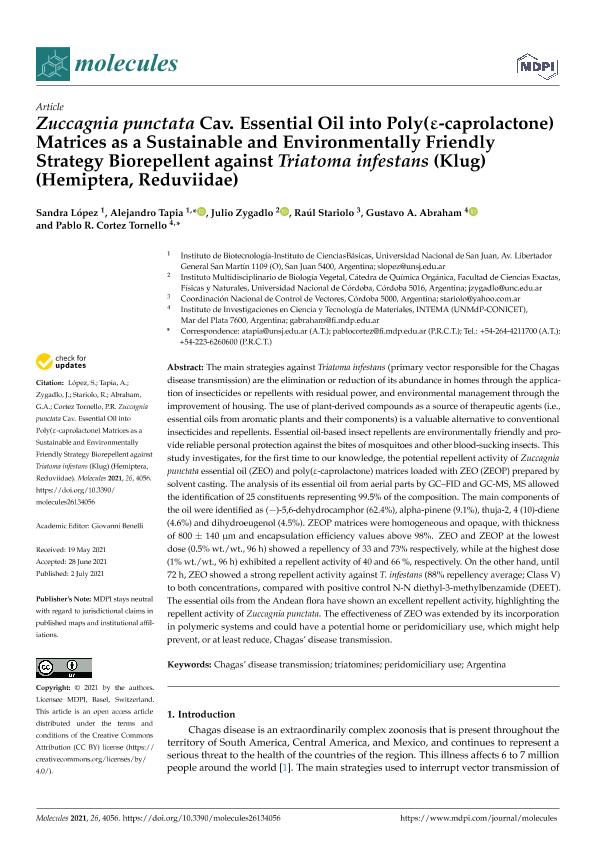Mostrar el registro sencillo del ítem
dc.contributor.author
López, Sandra
dc.contributor.author
Tapia, Alejandro

dc.contributor.author
Zygadlo, Julio Alberto

dc.contributor.author
Stariolo, Raúl Luis

dc.contributor.author
Abraham, Gustavo Abel

dc.contributor.author
Cortez Tornello, Pablo Roberto

dc.date.available
2022-05-12T15:38:42Z
dc.date.issued
2021-07
dc.identifier.citation
López, Sandra; Tapia, Alejandro; Zygadlo, Julio Alberto; Stariolo, Raúl Luis; Abraham, Gustavo Abel; et al.; Zuccagnia punctata Cav. essential oil into Poly(ε-caprolactone) matrices as a sustainable and environmentally friendly strategy Biorepellent against Triatoma infestans (Klug) (Hemiptera, Reduviidae); Molecular Diversity Preservation International; Molecules; 26; 13; 7-2021; 1-11
dc.identifier.issn
1420-3049
dc.identifier.uri
http://hdl.handle.net/11336/157379
dc.description.abstract
The main strategies against Triatoma infestans (primary vector responsible for the Chagasdisease transmission) are the elimination or reduction of its abundance in homes through the applicationof insecticides or repellents with residual power, and environmental management through theimprovement of housing. The use of plant-derived compounds as a source of therapeutic agents (i.e.,essential oils from aromatic plants and their components) is a valuable alternative to conventionalinsecticides and repellents. Essential oil-based insect repellents are environmentally friendly and providereliable personal protection against the bites of mosquitoes and other blood-sucking insects. Thisstudy investigates, for the first time to our knowledge, the potential repellent activity of Zuccagniapunctata essential oil (ZEO) and poly("-caprolactone) matrices loaded with ZEO (ZEOP) prepared bysolvent casting. The analysis of its essential oil from aerial parts by GC?FID and GC-MS, MS allowedthe identification of 25 constituents representing 99.5% of the composition. The main components ofthe oil were identified as ()-5,6-dehydrocamphor (62.4%), alpha-pinene (9.1%), thuja-2, 4 (10)-diene(4.6%) and dihydroeugenol (4.5%). ZEOP matrices were homogeneous and opaque, with thicknessof 800 140 m and encapsulation efficiency values above 98%. ZEO and ZEOP at the lowestdose (0.5% wt./wt., 96 h) showed a repellency of 33 and 73% respectively, while at the highest dose(1% wt./wt., 96 h) exhibited a repellent activity of 40 and 66 %, respectively. On the other hand, until72 h, ZEO showed a strong repellent activity against T. infestans (88% repellency average; Class V)to both concentrations, compared with positive control N-N diethyl-3-methylbenzamide (DEET).The essential oils from the Andean flora have shown an excellent repellent activity, highlighting therepellent activity of Zuccagnia punctata. The effectiveness of ZEO was extended by its incorporation in polymeric systems and could have a potential home or peridomiciliary use, which might help prevent, or at least reduce, Chagas? disease transmission.
dc.format
application/pdf
dc.language.iso
eng
dc.publisher
Molecular Diversity Preservation International

dc.rights
info:eu-repo/semantics/openAccess
dc.rights.uri
https://creativecommons.org/licenses/by-nc-sa/2.5/ar/
dc.subject
CHAGAS DISEASE TRANSMISSION
dc.subject
TRIATOMINES
dc.subject
PERIDOMICILIARY USE
dc.subject
ARGENTINA
dc.subject.classification
Otros Tópicos Biológicos

dc.subject.classification
Ciencias Biológicas

dc.subject.classification
CIENCIAS NATURALES Y EXACTAS

dc.title
Zuccagnia punctata Cav. essential oil into Poly(ε-caprolactone) matrices as a sustainable and environmentally friendly strategy Biorepellent against Triatoma infestans (Klug) (Hemiptera, Reduviidae)
dc.type
info:eu-repo/semantics/article
dc.type
info:ar-repo/semantics/artículo
dc.type
info:eu-repo/semantics/publishedVersion
dc.date.updated
2022-05-12T06:49:34Z
dc.journal.volume
26
dc.journal.number
13
dc.journal.pagination
1-11
dc.journal.pais
Suiza

dc.journal.ciudad
Basel
dc.description.fil
Fil: López, Sandra. Universidad Nacional de San Juan. Facultad de Ingeniería. Instituto de Biotecnología; Argentina
dc.description.fil
Fil: Tapia, Alejandro. Universidad Nacional de San Juan. Facultad de Ingeniería. Instituto de Biotecnología; Argentina
dc.description.fil
Fil: Zygadlo, Julio Alberto. Consejo Nacional de Investigaciones Científicas y Técnicas. Centro Científico Tecnológico Conicet - Córdoba. Instituto Multidisciplinario de Biología Vegetal. Universidad Nacional de Córdoba. Facultad de Ciencias Exactas Físicas y Naturales. Instituto Multidisciplinario de Biología Vegetal; Argentina
dc.description.fil
Fil: Stariolo, Raúl Luis. Coordinación Nacional de Control de Vectores; Argentina
dc.description.fil
Fil: Abraham, Gustavo Abel. Consejo Nacional de Investigaciones Científicas y Técnicas. Centro Científico Tecnológico Conicet - Mar del Plata. Instituto de Investigaciones en Ciencia y Tecnología de Materiales. Universidad Nacional de Mar del Plata. Facultad de Ingeniería. Instituto de Investigaciones en Ciencia y Tecnología de Materiales; Argentina
dc.description.fil
Fil: Cortez Tornello, Pablo Roberto. Consejo Nacional de Investigaciones Científicas y Técnicas. Centro Científico Tecnológico Conicet - Mar del Plata. Instituto de Investigaciones en Ciencia y Tecnología de Materiales. Universidad Nacional de Mar del Plata. Facultad de Ingeniería. Instituto de Investigaciones en Ciencia y Tecnología de Materiales; Argentina
dc.journal.title
Molecules

dc.relation.alternativeid
info:eu-repo/semantics/altIdentifier/doi/https://doi.org/10.3390/molecules26134056
dc.relation.alternativeid
info:eu-repo/semantics/altIdentifier/url/https://www.mdpi.com/1420-3049/26/13/4056
Archivos asociados
